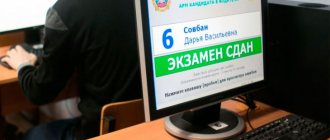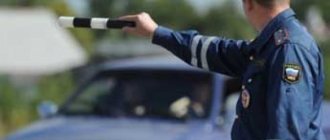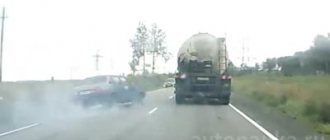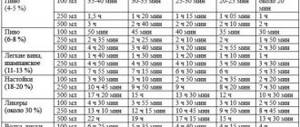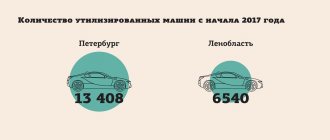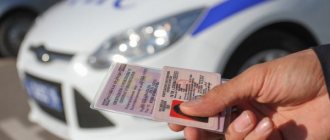To obtain a driver's license, you need to pass 3 exams: theory, as well as driving skills on a race track and in urban conditions. From the end of 2021, 2 practical exams in the traffic police are combined into one. During the test, the inspector pays attention to errors for which penalty points are awarded. According to the current penalty system, if the examinee scores more than 4 points, the exam is completed and considered failed. In this case, you will have to come for a retake. To avoid such developments, you should understand the specifics of calculating penalty points.
Penalty points and mistakes on the race track
In 2021, the fine system at the circuit was completely abolished. This has made passing the test much more difficult, because now almost any mistake leads to taking it again. The overwhelming number of violations are considered gross. The exam will inevitably fail if:
- the student did not start completing the task within 30 seconds from the moment the inspector gave the command;
- the dimensions of the car crossed the marked boundaries or the wheel ran over a solid line of road markings;
- the car crossed the “STOP” line;
- the car has not reached the control line;
- the examinee violated the specified trajectory;
- the car rolled on the overpass more than 30 cm;
- the time given to complete the exercise has expired;
- completing the “Speed Maneuvering” task took more than 35 seconds;
- The student ran a red traffic light.
Refusal to perform one or another exercise when taking an exam is also considered a gross violation. Inspectors never compromise and leave no choice. The only mistakes allowed on the race track (but no more than once): running into a cone, suddenly stopping the engine, touching the road with your feet when this is not provided for by the task.
What is the main purpose of the exam?
During the traffic police exam, the goal is not to get somewhere, much less to have time to get somewhere.
There is only one goal - to demonstrate compliance with the Rules to the last point and comma, as well as the adequacy of one’s behavior on the road. Of course, everyone understands (including the examiner) that there is no 100% strict adherence to the rules on the roads, but such driving must be demonstrated during the exam. This is a guarantee that a person who has passed the exam can be responsible for his actions on the road, including even if he does not comply with one or another letter or clause of the rules.
Penalty points on the exam in the city
During the traffic police exam, which tests driving skills in urban conditions, all violations of traffic rules are taken into account. The fine system provides for 3 categories of violations: minor, medium and gross. The first is assigned 1 point, the second - 3, the third - 5. The total allowed number is 4 points. If the total number exceeds it, the examinee will be sent for a retake. Accordingly, even one gross error entails early completion of the test.
The student will earn 1 penalty point if the inspector notices at least one minor violation:
- forgot to turn on the low beam;
- turned on the turn signal early;
- did not use mirrors;
- drove into someone else's lane while driving;
- moved too fast for the prevailing weather conditions;
- interfered with other road users at low speed;
- braked sharply (allowed only to avoid an accident).
If the examinee performs maneuvers uncertainly, the traffic police inspector will also credit his account with the appropriate fine. The listed situations are far from the only ones that can prevent you from successfully passing the exam. They are distinguished from moderate and severe violations by the least danger.
If the examinee makes one of the following mistakes, the inspector will rate the violation as 3 points:
- did not use a seat belt;
- did not check if all doors were closed;
- did not turn on the turn signal;
- got distracted by the phone while driving;
- when I was reversing, I didn’t turn on the emergency lights;
- stopped under a prohibitory sign or at a zebra crossing;
- didn't brake when needed.
The State Traffic Inspectorate inspector can deliberately create a provocative situation in order to monitor the reaction of the examinee. For example, ask to look at the time on the phone, or not close the door. Although the rules prohibit this. Despite the fact that the request came from the examiner himself, violating traffic rules is unacceptable under any circumstances.
The exam will fail if the student makes at least one serious mistake. They carry the heaviest fines because they can lead to serious consequences on the road. Running a red light, ignoring markings, overtaking incorrectly, speeding, driving beyond the stop line or into the oncoming lane within a few seconds can lead to an accident. Therefore, there can be no talk of any leniency here. Also, as in the case of the race track, if the student refuses to comply with the requirements of the inspector in the city, he is removed from the test.
The traffic police exam is not a court, but a filter
Before giving specific examples, let's figure out why and who needs an exam at all.
For a “driver candidate” (that’s what the examinees are called: they are no longer students, but not yet “drivers”) the answer is obvious - to get a “License”.
For the examiner, the purpose of the exam is to answer the question: can this candidate driver be entrusted with independent driving, that is, in the literal sense of the word, hold him responsible for his future actions on the road. Moreover, the examiner can answer this question only by looking from the outside at the external actions of the examinee. It is by these actions (correct or incorrect) that you can convince the examiner of what result he should give - PASS or FAIL.
An exam is not a court where a verdict is passed, but a filter. Those who are not ready to drive independently should not pass through this filter. Moreover, even if some of those who are objectively ready to drive independently do not pass, this will not be a problem, unlike the situation if those who are not ready pass this filter.
Evaluation Rules
All possible errors that are taken into account during the exam are listed in the Checklist in Appendix 8 of the relevant Regulations. In addition to the essence of the violation, it is indicated which points of the traffic rules it corresponds to and the degree of its “severity” in points. Errors are recorded on the examination sheet, so it is extremely difficult to accuse the examiner of bias. The risk of test failure can only be minimized through regular practice. The more a person drives, the more confident he feels behind the wheel.
Very few people get a driver's license after the first attempt at the State Traffic Inspectorate. Driving around the city requires strict adherence to a large number of rules. And due to lack of experience, future drivers get lost or forget what they learned. The need to come for a retake should be taken as a chance to further improve your own skills, so as not to become involved in an accident in the very first days after receiving your license.
The traffic police exam is a game, but the road is not!
It is better for driver candidates to perceive the exam as a game.
On the part of the examinee, the goal of this game is to prevent the examiner from catching him in violating the Traffic Rules - right down to the last letter, period or comma!
On the part of the examiner, the goal of the game is the opposite - to convict the candidate of violating some points of the Rules or safety standards on the road.
On the one hand, this game should not allow unprepared drivers onto the road, and on the other hand, it should only allow those who can objectively bear responsibility for their actions onto the road.
It must be emphasized that the exam is called a game here, but the road is not a game! When a driver candidate gets a license and becomes a driver, things immediately get serious. The responsibility is already entirely on him, and he must understand this.
Rules for retaking the exam in the traffic police
But some unfortunate drivers who are unable to answer all the questions correctly or master the practice, even though many attempts have already been made, are always interested in how many times can they take the traffic rules exam?
Sometimes there may be a problem with retaking. That is, there are long queues in the previously selected department, and you will have to wait a very long time for your opportunity to receive a certificate. Then students, wanting to get their license as quickly as possible, choose other institutions that are not so busy for this institution.
Penalty points from September 1, 2021
Gross errors - 5 points
| Common mistakes | Traffic rules |
| 1.1. Did not give way (created an obstacle) to a vehicle having the right of way | 3.2, 8.1, 8.3-8.5, 8.8, 8.9, 8.12,9.6, 11.7, 13.4-13.6, 13.8, 13.9, 13.11, 13.12, 15.1, 18.1, 18.3 |
| 1.2. Did not give way (created an obstacle) to pedestrians who have the right of way | 8.3, 13.1, 13.8, 14.1, 14.3, 14.5, 14.6 |
| 1.3. Drifted into oncoming traffic (except in permitted cases) or onto oncoming tram tracks | 8.6, 9.2, 9.3, 9.6, 9.8, 9.12 |
| 1.4. Driving through a prohibiting traffic light or traffic controller signal | 6.2-6.4, 6.7, 6.9, 6.10 |
| 1.5. Did not comply with the requirements of priority signs, prohibitory and mandatory signs, road markings 1.1, 1.3, as well as signs of special regulations | Appendices No. 1 and No. 2 to traffic rules |
| 1.6. Crossed the stop line (marking 1.12) when stopping in the presence of sign 2.5 or with a prohibiting traffic light signal (traffic controller) | 6.13, Appendix No. 2 to the traffic rules |
| 1.7. Violated the rules for overtaking | 11.1-11.4 |
| 1.8. Violated the rules for making a turn | 8.5-8.7 |
| 1.9. Violated the rules for performing a U-turn | 8.5, 8.8, 8.11 |
| 1.10. Violated the rules for reversing | 8.12 |
| 1.11 Violated the rules for crossing railway crossings | 15.1-15.4, 12.4 |
| 1.12. Exceeded the set speed limit | 10.1-10.4 |
| 1.13. Did not take possible measures to reduce the speed up to a complete stop of the vehicle when there was a danger to traffic | 10.1 |
| 1.14. Violated the rules of ahead of vehicles when passing pedestrian crossings | 11.5, 14.2 |
| 1.15. Overtook a vehicle that has special color graphics applied to its outer surfaces with a blue flashing light and a special sound signal turned on, or a vehicle accompanied by it | 3.2 |
| 1.16. Action or inaction of a driver candidate that necessitated intervention in the process of driving an examination vehicle in order to prevent an accident | |
| 1.17. Did not complete (ignored) the examiner’s task |
Average errors - 3 points
| Common mistakes | Traffic rules |
| 2.1. Violated the rules of stopping or parking | 12.1-12.5, 12.7, 12.8 |
| 2.2. Did not signal with a turn signal before starting to move, change lanes, turn (U-turn) or stop | 8.1 |
| 2.3. Did not comply with road marking requirements (except for markings 1.1, 1.3 and 1.12) | Appendices No. 1 and No. 2 to traffic rules |
| 2.4. Did not use hazard warning lights or warning triangles when required | 7.1, 7.2 |
| 2.5. Entered an intersection when there was a traffic jam, interfering with the movement of a vehicle in the transverse direction | 13.2 |
| 2.6. Didn't fasten your seat belt | 2.1.2 |
| 2.7. Violated the rules for transporting passengers | 22.7 |
| 2.8. Used your phone while driving | 2.7 |
| 2.9. In established cases, did not reduce speed or stop | 14.2, 14.7 |
Minor errors - 1 point
| Common mistakes | Traffic rules |
| 3.1. Didn't give the turn signal in a timely manner | 8.2 |
| 3.2. Violated the rules for placing a vehicle on the roadway | 9.3, 9.4, 9.7-9.10 |
| 3.3. Selected driving speed without taking into account road and meteorological conditions | 10.1 |
| 3.4. Traveled unnecessarily at too low a speed, causing interference with other vehicles | 10.5 |
| 3.5. Braked sharply when there was no need to prevent an accident | 10.5 |
| 3.6. Violated the rules for using external lighting devices and sound signals | 19.1-19.5, 19.8, 19.10 |
| 3.7. Committed other traffic violations | |
| 3.8. Incorrectly assessed the road situation | |
| 3.9 Didn't use rear view mirrors | |
| 3.10. Unconfidently used the vehicle controls and did not ensure smooth movement | |
| 3.11 The engine stalled during the exam |
How to prepare and not fail driving
The main part of the training consists of high-quality mastery of the training material and practicing practical driving. Together with the instructor, you must drive at least once along each of the possible routes that may appear during the city driving test.
When preparing, you should pay attention to the most common errors:
- An incorrect stop at the road sign “Driving without stopping is prohibited.” Most cadets only slow down slightly in front of the sign, without stopping the vehicle completely. A correctly performed exercise looks like this: the car completely stopped in front of the sign and was motionless for 3-4 seconds (for this you need to mentally count to 3).
- Passing a pedestrian in a place where he does not have the right of way. Mandatory areas where pedestrians should be given the right of priority to cross the roadway are marked zebra crossings, turns at intersections and controlled pedestrian crossings. If a person tries to cross the road in another place, counting on the low speed of the training vehicle, then he should not be allowed to pass. A pedestrian who has already entered the road in the wrong place must be allowed to pass in order to avoid an emergency.
- When taking the test in a car with a manual transmission, you must carefully monitor the position of the gearbox lever: when stopping, it must be in the neutral position, and when starting to move, only with first gear engaged.
Questions and answers
Ivan, the traffic police inspector, gave five points during the exam for uncertain use of the car. One point for each action. Is this legal or not?
Answer Yes, the inspector has the right to assess the level of your behavior on the road.
Anatoly Passed the exam, the bus began to leave the stop. I slowed down to let him pass. For this I was given five penalty points. What can be done?
Answer You can go to the traffic police department and discuss with the inspector why exactly you were given points. If you had a dash cam in your car, you can ask to view the recording of your driving.
Vladimir I took the exam and received eight penalty points, they told me that I failed. At the same time, my instructor later told me that I drove according to the rules and did not break anything. What can be done in this situation?
Answer You can file a complaint with the head of this traffic police department. Alternatively, you can go to court. You can call your instructor as a witness. Also, a video recorder should have been installed in the car. You can ask the instructor to give you the videotape and attach it to your complaint for the court.
Penalty points until September 1, 2021
Gross errors - 5 points
| Common mistakes | Traffic rules |
| 1.1. Did not provide an advantage in traffic to drivers of vehicles having such right (created an obstacle) | 3.2, 8.1, 8.3-8.5, 8.8, 8.9, 11.7, 13.4-13.6, 13.8, 13.9, 13.11, 13.12, 15.1, 18.1, 18.3 |
| 1.2. Did not provide priority in traffic to pedestrians and (or) cyclists who have such a right | 8.3, 13.1, 14.1-14.3, 14.5, 14.6 |
| 1.3. Drifted into oncoming traffic or tram tracks in the opposite direction | 8.6, 9.2, 9.3, 9.6, 9.8 |
| 6.2-6.5, 6.7, 6.9, 6.10 | |
| 1.5. Did not comply with the requirements of priority signs, prohibitory and mandatory signs | Annex 1 |
| 1.6. Crossed the stop line (marking 1.12) when there was a sign 2.5 or when there was a prohibiting traffic light signal (traffic controller) | 6.13, Appendix 2 |
| 1.7. Violated the overtaking rules | 11.1-11.5 |
| 1.8. Violated the U-turn rules | 8.8, 8.11 |
| 1.9. Before turning right, left or making a U-turn, did not take the appropriate position on the roadway, taking into account clause 8.7 | 8.5 |
| 8.12 | |
| 15.1-15.4, 12.4 | |
| 1.12. Did not take possible measures to reduce speed, even to a complete stop, if there was a danger to traffic | 10.1 |
| 1.13. Action or inaction of a driver candidate that necessitated intervention in the process of driving an examination vehicle in order to prevent the occurrence of an accident |
Average errors - 3 points
Minor errors - 1 point
| Common mistakes | Traffic rules |
| 3.1. Didn't fasten your seat belt | 2.1.2 |
| 3.2. Failure to turn on and turn off the turn signal in a timely manner | 8.2 |
| 3.3. Violated the rules for placing a vehicle on the roadway | 9.3, 9.4, 9.7-9.10 |
| 3.4. Selected driving speed without taking into account road and meteorological conditions | 10.1 |
| 3.5. Moved unnecessarily at too low a speed | 10.4 |
| 3.6. Braked sharply when there was no need to prevent an accident | 10.4 |
| 3.7. Violated the rules for using external lighting devices and sound signals | 19.1-19.5, 19.8 |
| 3.8. Inattentive towards other vehicles | |
| 3.9. Uses vehicle controls unconfidently, does not ensure smooth movement and braking | |
| 3.10 Does not use rear view mirrors | |
| 3.11 Allowed the wheels of the vehicle to lock when performing emergency braking | |
| 3.12. Other traffic violations |
